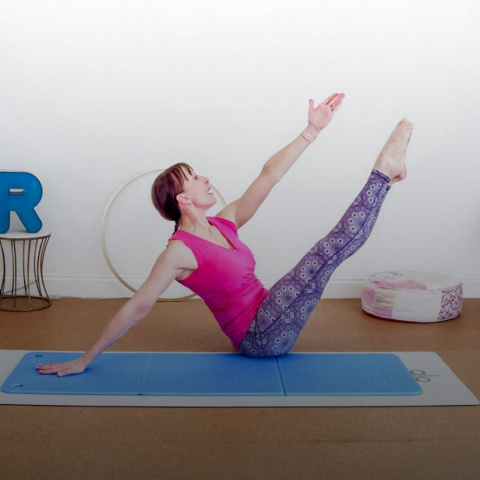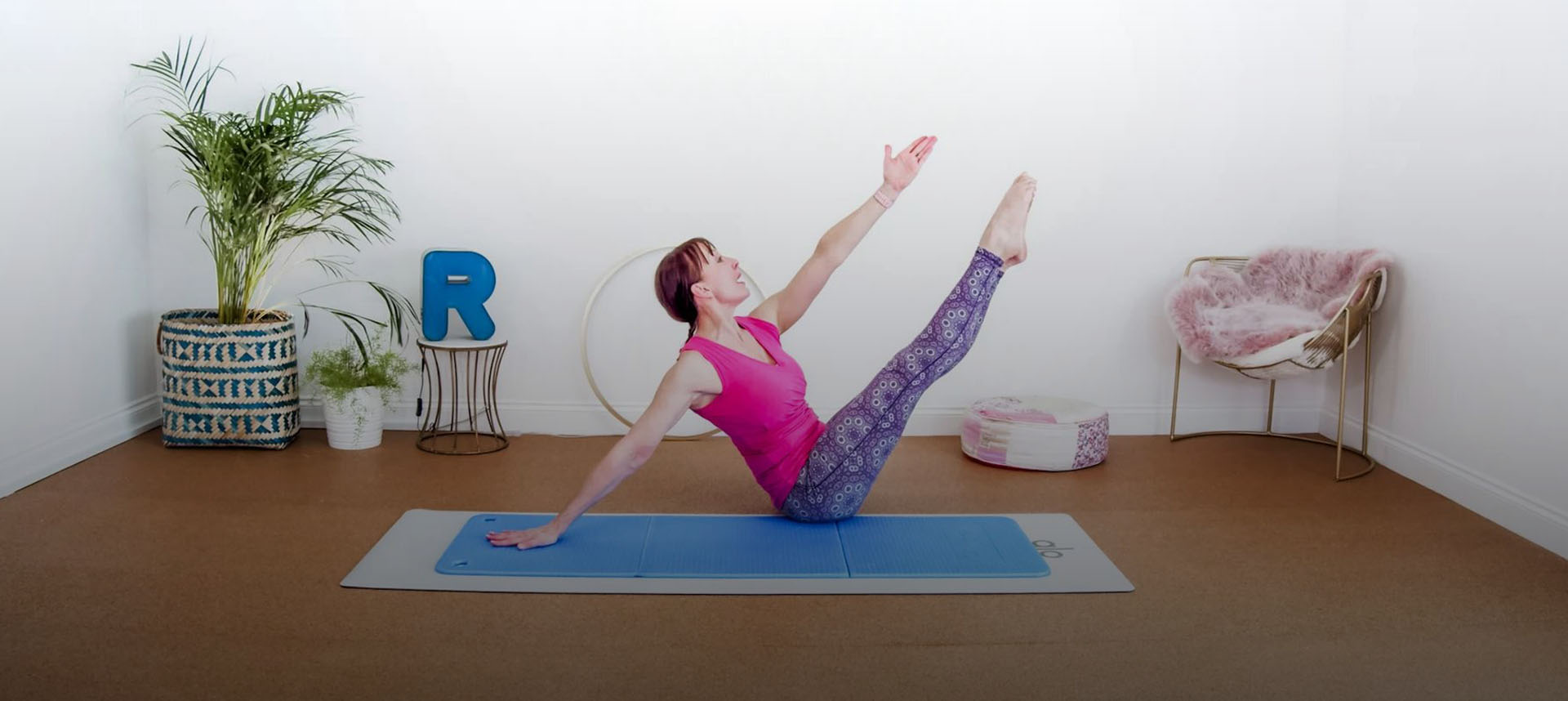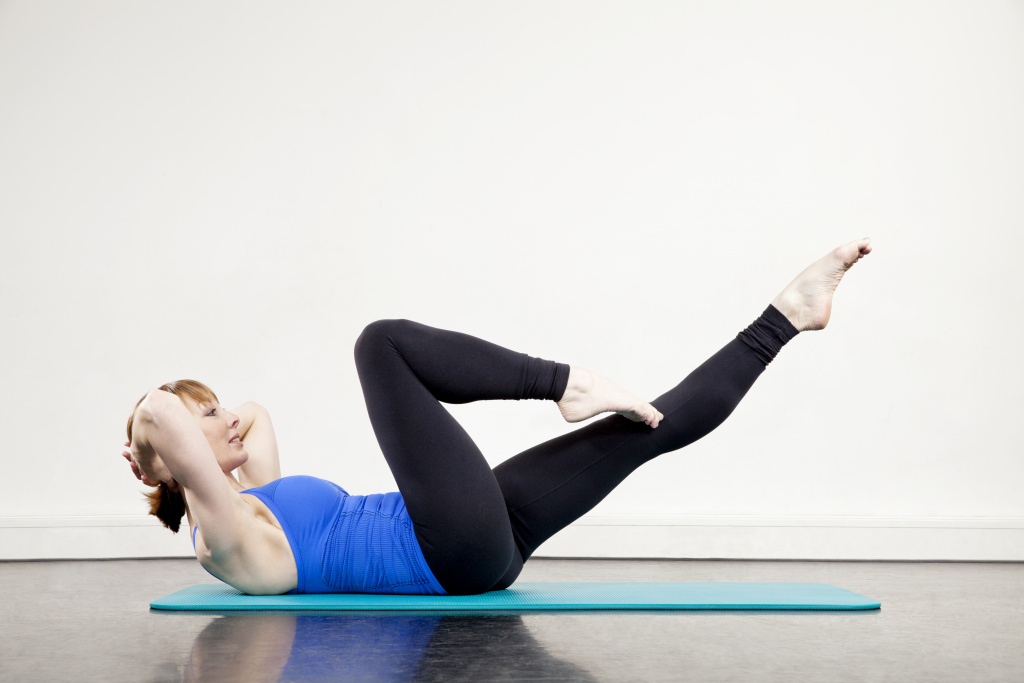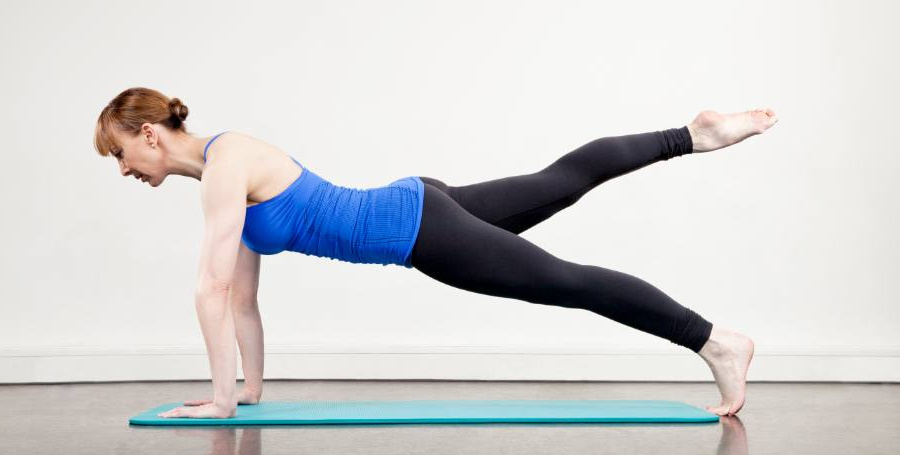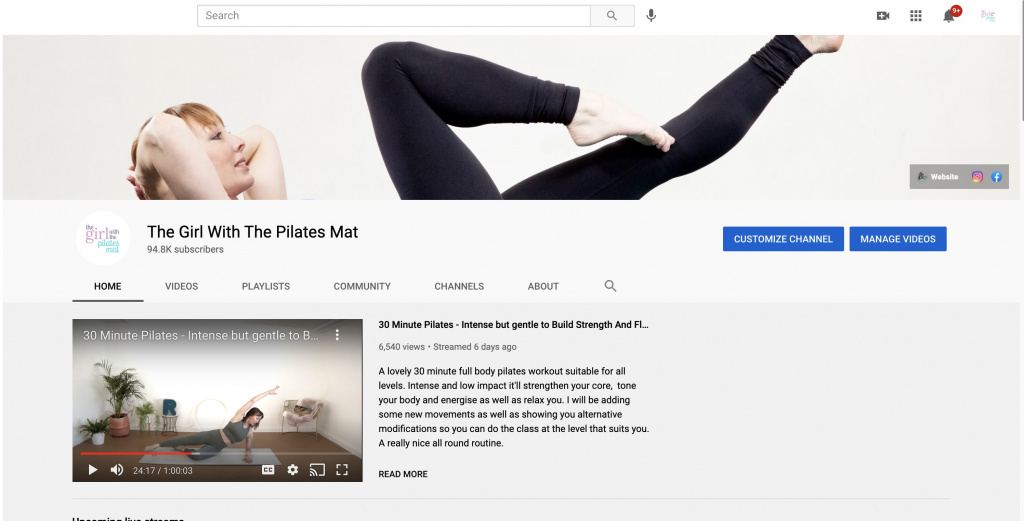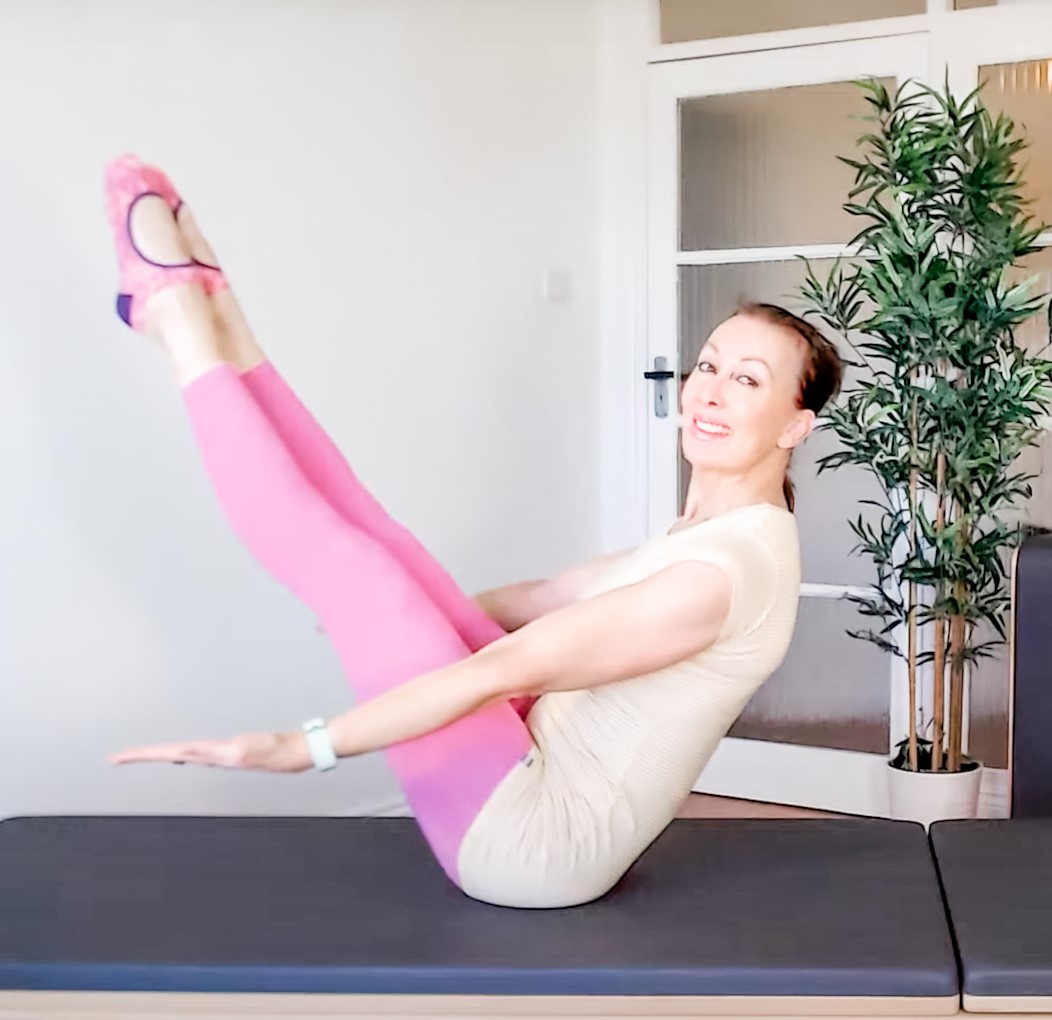Rachel Lawrence is a Pilates teacher – certified by BASI Pilates – and YouTuber, with close to 100,000 subscribers on the platform. Her most viewed video has been watched more than two million times over the course of the past year and her channel is showing no signs of slowing down. She releases new Pilates workouts each week, including strength and flexibility workouts, routines for seniors, and dance-related Pilates content too.
Here’s what she had to say when we caught up with her…
Tell me about your journey with Pilates. What’s your story?
I trained as a dancer from the age of three, and I did ballet, modern, jazz, tap, pretty much everything, and I went into dance professionally when I was quite young, at seventeen. I left theatre school early to go and do it because I just wanted to get out into the world. At that point in time, Pilates wasn’t really that well known and I was in a show where I was performing twice a day during the week, three times on Saturday and three times on Sunday, and my body just got completely wrecked.
As you can imagine, dancing is very hard on the body, and about three and a half years into my dancing career I split the meniscus cartilage on my right knee, and it was basically game over. I couldn’t dance professionally anymore, and even though I did have some rehab I couldn’t dance at the level I was doing.
So, I gave all that up, retrained, and went into broadcast journalism, and worked in television for many years. It was while working in television that I found out about Pilates, because as I was making a TV series out in New York. It all sounds very glamorous, but I was doing all the filming and camerawork myself, and I injured my back quite badly. It went into a complete spasm. It was that bad that I couldn’t get out of bed and I had to phone the production team the next morning and tell them that I simply could not move. My back was in so much pain.
They called out an osteopath to come and meet me and as I was chatting with him, explaining how I had been a dancer and had been forced to give it up, he asked me if I had ever done Pilates. He said he thought I’d really like it. He explained that a lot of dancers do it and they use it a lot for rehab. I didn’t really know anything about it and while I was out in New York, I went off to a Pilates studio somewhere on 8th Avenue, tried a Pilates class, and I absolutely loved it. The reason I think I enjoyed it so much was that coming from a dance background, I liked the attention to detail because when you train in ballet, every little movement, every finger and toe is assessed and Pilates is quite similar.
I really enjoyed it, came home and in London I just sought out teachers where I could. This is going back a long time, 20-plus years, and there weren’t that many around at the time, so I tried with different teachers and tried to find something I liked. At that point it was just mat Pilates and I started learning about Pilates apparatus, found out more about Joseph Pilates and the fabulous machines he invented. So, I was just doing mat work, but then tried reformer Pilates and Cadillac also. I was doing around 4-5 sessions a week alongside trying to keep my television job going, and it’s just over ten years ago when I decided that I loved it so much that I was going to start doing it for a living. I decided to retrain, so flew to California and did all my training over there, came back to London and started my classes.
You must have really loved it to want to completely change your career path?
It’s the dancer’s mentality in me I think. I loved growing up and doing dance and although I never danced at a super-high level, I was training every day and I loved the attention to detail and trying to really grasp a technique and do a movement correctly, and there’s a real similarity with Pilates. There’s all different types and schools of Pilates, but the fundamental aspect of Pilates is mindful movement, using your brain to learn how to move your body and understand your body better. We all have the same muscles, we all have a spine, but we are all still different. It’s trying to learn about your body and what works well for you and that’s what I really liked about it. It always felt quite holistic and quite personal, in the same way dance is. If you’re doing a dance movement, everyone can take an arm out, but we’ll all do it slightly differently because of how we want to express ourselves through the movement. I think Pilates is the same; you learn what works for you within the discipline – there are set movements we all do and you can adapt them to suit your body. That’s what makes it work for me.
What is it that inspires you to do what you do?
That’s a really good question. It was initially the fact that it fixed my knee, that was a big tick. And when I say it fixed my knee, I don’t mean my knee isn’t torn anymore, it is, but I’d gone through more than ten years of not dancing and within four months of doing regular Pilates, I could go back into a ballet studio, albeit not as a professional, but just a partaker of, and I could do everything that I could do before. The fact that Pilates brought my body to a point where I could do what I wanted to do, that’s what inspires me. It’s not the fact that you have to be a Pilates addict and say “oh, I only do Pilates” it’s the fact that if you do it, it will help and support everything else that you want to do, whether that’s playing football or rugby, or you’re someone who loves to run or cycle, Pilates will support it.
It’s a really good supplementation tool for so many other things…
It is. I find a lot of other people I teach, who I call my super-fit group, use it as part of their cross-training. It’s low impact, so you’re not impacting upon the joints at all, but you are moving them in all the ranges and planes of motion and so it’s just a super body-conditioning routine.
I tell everyone that they should be moving every day, no matter what their favourite forms of exercise are, and that if they can, to incorporate a little bit of Pilates each week. Because Pilates resets the body. It gets the spine working, the shoulder joints, the neck muscles, it just gets everything moving. Then you’re less likely to get injured and that’s the other big thing about Pilates; it works so well to prevent injuries. That’s why now you’ll see a lot of the major football clubs and rugby clubs doing Pilates as part of their cross-training. All the ballet companies have on-site Pilates studios or teachers that come in. It’s there to support them and everything they do.
What is it about Pilates that made you want to share it with others?
I think it was because I had gone from being in a place where I didn’t think I was going to move again, to being able to do exactly what I did before, and that was quite life-changing for me. I don’t know about yourself, but anyone reading this who’s been doing a sport and has had to stop because of injury will know how devastating that is. I think that’s the main thing for me; it can get you back to that point where you can pretty much do whatever you want.
So, moving on to YouTube. What made you start your channel?
I’ve got to be honest, it started as a bit of an experiment. The idea was this; I come from a really poor family and we didn’t have any money at all, so I was very lucky that I got a scholarship when I was younger that helped me train in dance. So, I’ve kind of had that mindset that if I can ever get to the point where I can give back then that’s what I want to do. There might well be people out there that would like to do Pilates, but in the area they live in it might not be accessible, or perhaps it’s too expensive. So, the plan was to put a few of my workouts on this channel to see if anybody watches it and I’ll be honest, for probably a year or so I would only put one out every few weeks; I didn’t have any real organisation about it, or any structure or plan. What happened after that, as we all know, is that COVID came along, and by that time I think I had made 10-15 videos. When the pandemic was announced and suddenly we were all just locked down, I thought “well, this is the time that people really need to do Pilates” as they can’t go anywhere, they can’t go to clubs, etc. so why don’t I just offer it online for free and see who comes along? I think a year and a half ago I had 3,500 subscribers and today I have 99,315.
It is incredible and I don’t really know what it is. I think it’s partly that people couldn’t go out and so would look online, but it’s really interesting because I got told by a lot of businesspeople when I first set up in London that I shouldn’t ever do anything for free because people won’t value what you do if you do it for nothing. I’ve not found that to be true. I mean YouTube is essentially free for anyone who wants to come and watch my videos or take part with them, they don’t have to pay for it. But, what I’ve found, is that the people who come along, really appreciate what you’re doing and they recognise the quality of what you’re doing as well. As far as I’m concerned, it’s a win-win, and I just want to keep on going with it.
What does it feel like to have a video with more than two million views?
Absolutely crazy! That is really crazy, and it’s so funny because you get the analytics from YouTube, about what your top videos are etc. and it’s always the same one. I put the ‘Standing Pilates for Seniors’ video out a year ago and the reason I did that was because when I had my business in West London, pre-Covid, I used to do one seniors class a week. I just loved teaching them because they were all lovely people. They were all really grateful that someone was just thinking about them and how to keep them fit and healthy. These were people that ranged from ages 65-87 who would come to my class, and what I noticed was when I was working with them before Covid, was how much their balance and wellbeing improved over about three or four months of us doing that class. So, it was one of those classes I kept going and when Covid hit the first thing I thought about was “where are they going to go? How are they going to get Pilates online?” I made that video and the video is around half of the content of the class I used to teach. As you can see it’s just gone crazy.
What’s the goal with YouTube then?
I’d like a million subscribers! That’s where I’d like to get to. I’m a great admirer of other channels like Yoga with Adrienne, she’s been a bit of an inspiration to me actually. She started in the same way, just giving yoga to people, and whatever she does, she does with integrity. I know that yoga is always going to be more popular than Pilates, but realistically, if I could get to one million, that would be wonderful, so that’s the goal!
When I get to 100,000 subscribers, I think I’ll do a big live class or something like that. Ever since the second week of lockdown, I’ve been doing a live class every Friday and that’s still going really strong. There are always around 300 people who do it live with me and usually by the end of the weekend it’s up to around 3000-5000 views. I like doing the live classes and I think I’ll keep going because people like the idea that you’re there at that time as well.
Is there anything we should look out for from you in the near future?
Yes. The idea is that I want to create a bigger platform on YouTube, and I want to keep the content available for everyone, so there won’t be any exclusive memberships or anything like that. The plan is simply to deliver more content on a more regular basis. At the moment I do a live on a Friday and one pre-recorded upload a week, but people are always asking me for more. I’m going to slightly expand from doing just Pilates and do some dance-based workouts as well. They’ll all be workouts that can be done by non-dancers, but they’ll be based on my whole background, which is many years of doing dance alongside Pilates.
To see more of Rachel, visit her YouTube channel or check out her Instagram.
Alternatively, if you are interested in becoming a Pilates teacher, take a look at our Level 3 Diploma in Teaching Mat Pilates.
